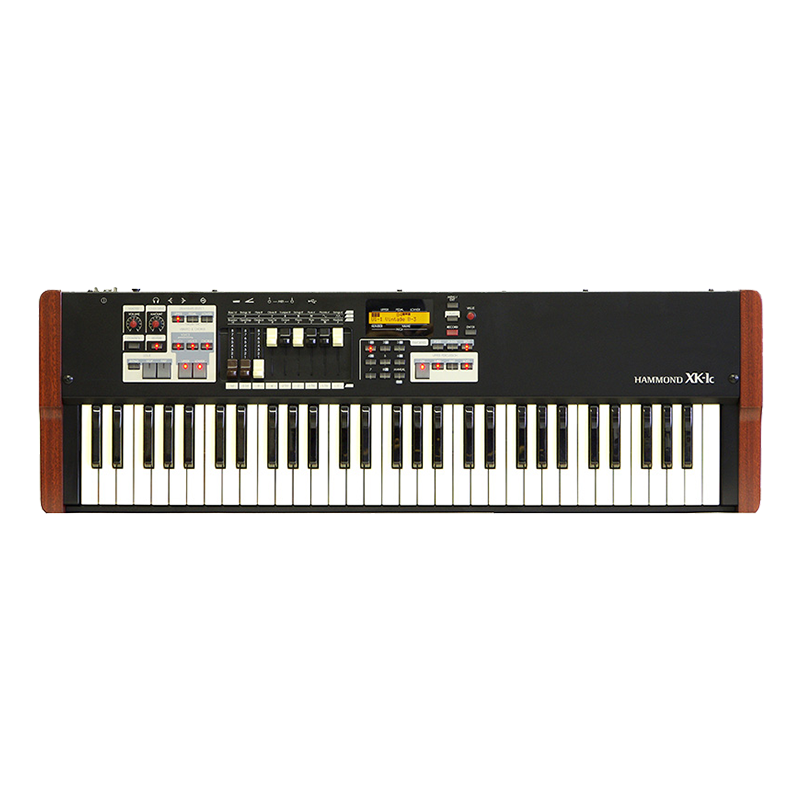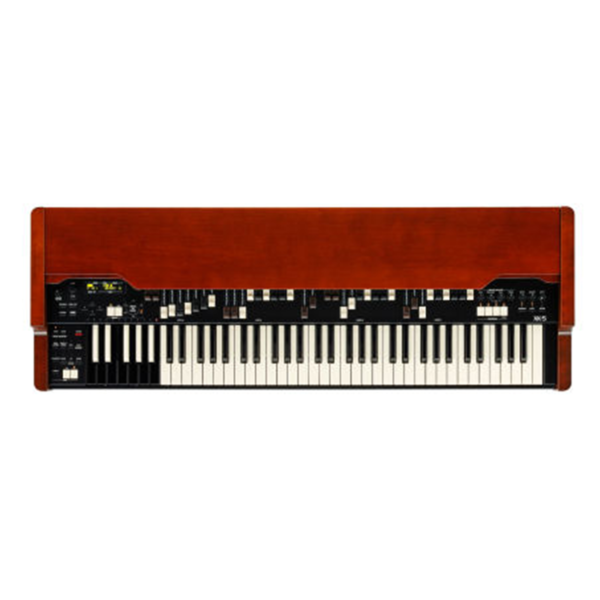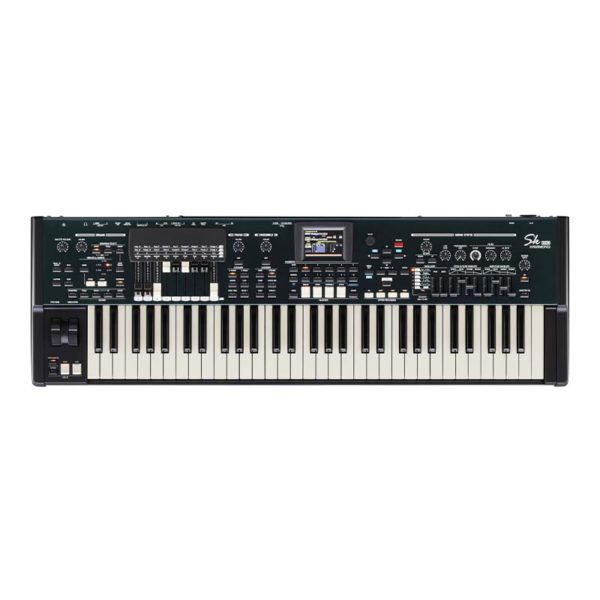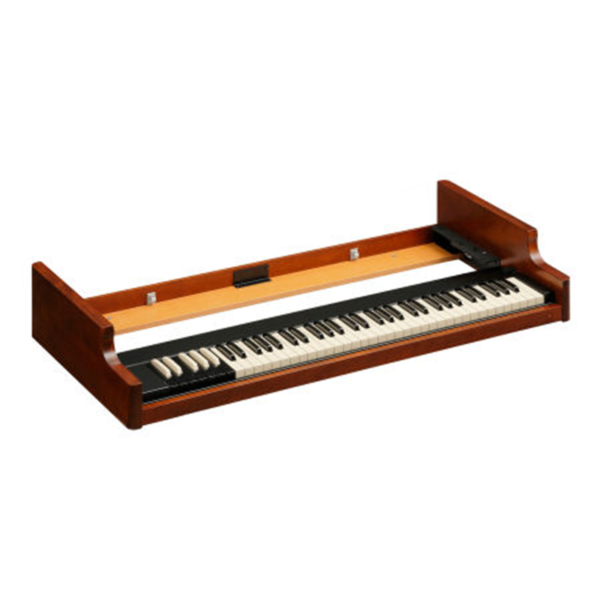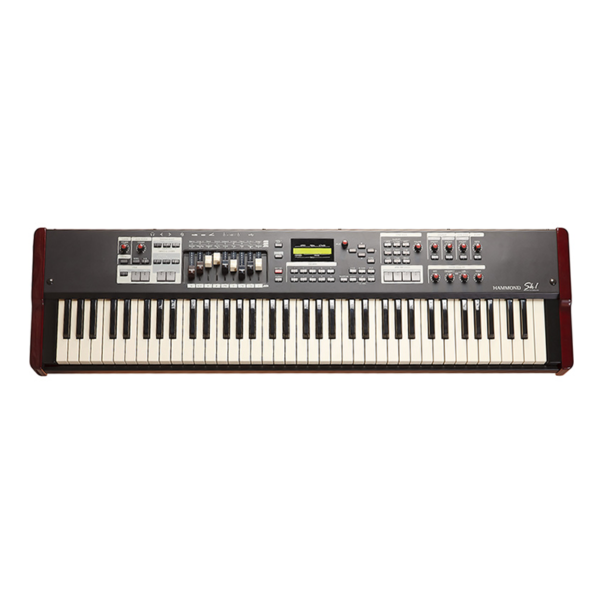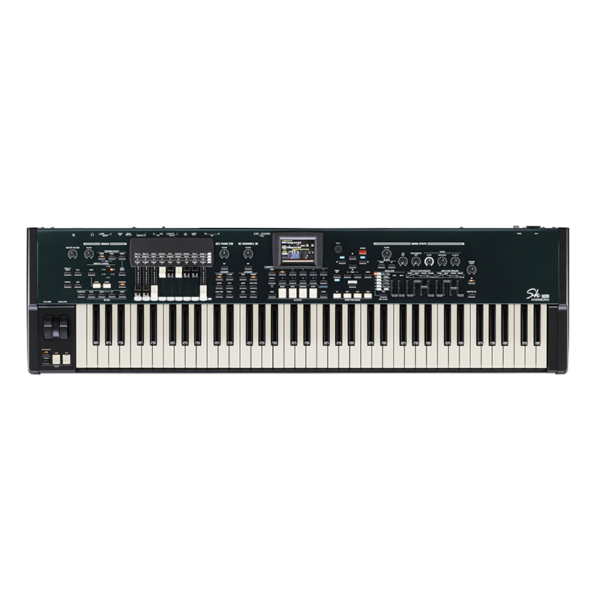The Hammond Xk-1c is the smallest and lightest Genuine Hammond Organ ever offered. There was a time when the roaring sound of a genuine Hammond B-3 Organ and Leslie Speaker required a moving van with burly movers, and room enough on stage to stand 4 regular musicians. Those days are truly now behind.
The Hammond XK-1c provides the full majesty and versatility of the industry standard B-3 in a compact package weighing just 16 pounds, with a price modest enough for everyone’s budget.
Following the lead of the wildly popular SK series of ultralight keyboards, the XK-1c uses the same Virtual Tonewheel “engine” as Hammond’s flagship B3-mkII Console Organ, with all the traditional elements, such as Hammond’s original Chorus/Vibrato and Touch-Response Percussion™. Our authentic selection of digital Leslie cabinets are also onboard, completing the classic setup; bringing the “King Of Instruments” within reach of anyone desiring it.
The XK-1c features extensive customization capabilities, allowing the Organ to be tailored into replicating any Hammond/Leslie vintage, with all settings stored in each patch. Most common aftermarket “Hot Rod” modifications are possible within the editing facilities, as well. A wide variety of different Hammond tones are contained in the factory patch library. Our extensive Artist roster contributed many of the patches found on the Xk-1c. It will “scream, purr, and cry” right out of the box. There are 64 Factory patches and 64 User-programmable patches available.
In addition to the Drawbar Profiles, the sounds of two of the most popular transistor combo organs are included (“Farf” and “Vx”), along with 28 equivalent ranks of Classical Pipe Organ sounds. The Combo Organ and Pipe Organ voices may be fully registered in traditional fashion via the Drawbar controls.
Hammond USA Sales Manager Steve Simmons says: “The XK-1c’s diminuitive size is shocking when compared to its massive tone, but one touch of the traditional waterfall keyboard tells the truth that the XK-1c is the real deal, not a clone or imitation, but a genuine Hammond Organ, worthy of the name and the legacy of nearly 80 years.”
GENUINE AND AUTHENTIC HAMMOND ORGAN
Authentic Chorus-Vibrato/Touch Response Percussion/Overdrive
12 HAMMOND MACRO PROFILES with 17 TWEAKABLE PARAMETERS
each USER-PROGRAMMABLE
3 BLANK USER-PROGRAMMABLE PROFILES
96 INDIVIDUALLY Adjustable, Voiceable Digital Tonewheels
DIGITAL TONEWHEEL GENERATOR
Laurens Hammond’s original Organ (invented in 1935) had an intricate electro-mechanical mechanism that used 96 Quarter-sized wheels spinning on driveshafts powered by his patented synchronous motor. The wheels were notched according to pitch, and an electromagnetic pickup (much like that on an Eelectric Guitar) sensed those notches and rendered a musical note. The Drawbars combined those harmonic tones to produce the inimitable Hammond Organ sound.
Hammond’s adherence to quality has allowed many vintage instruments to remain vital today, and they are among the most desired and imitated musical instruments ever, but at a high cost. The Electromechanical Hammonds require expensive maintenance, regular doses of oil, and were of great weight; not easy to move at all.
The Modern Hammond Organ’sXk-1c’s VASE III “Engine” uses the exact model of Laurens Hammond’s design, executing it in the digital realm, with no moving parts, retaining all of the nuances, imperfections and idiosyncrasies of the original. The wheels are always “spinning”. When a note is played, the tones pass, just as water through a faucet. The random starts of each wave played allow for phase interaction, producing the rich tone so prized in the vintage Hammonds.
The Digital realization of Laurens Hammond’s System allows sophisticated control of every facet. Each Digital Tonewheel can be voiced for Volume, Timbre, Motor Noise and Leakage; enabling the musician to tailor the Modern Hammond to match the characteristics of any Vintage Hammond, or to create their own vision. Twelve Macro Profiles allow the user to quickly select the most popular “kinds” of Hammond, from Showroom-New to Road-Worn Antique and all points between.
CLASSIC HAMMOND COMPONENTS
The Tonewheel Generator wasn’t the only great invention of Laurens Hammond, and no Hammond Organ would be complete without the full spectrum of ingredients that comprised Mr. Hammond’s genius design.
DRAWBARS:
Mr. Hammond used the Pipe Organ Design concept of “Unification” in creating the iconic Drawbars of his Electronic Organ. This concept allowed one or more keyboards to control the pitches of many pipes within one set or “rank” of pipes. Adopting the harmonic standards and nomenclature of the Pipe Organ, Mr. Hammond’s design assured that any organist would be able to play his instrument without a steep learning curve. Unlike the Pipe Organ, Mr Hammond’s design allowed variable volumes of each Harmonic represented by each drawbar. This variation gave the musician millions of combinations of harmonics, and assured that every Hammond player would be able to summon a unique voice. An extra level to the expression a Hammond Organist had at their fingertips was added because the Drawbars could be manipulated in real time. The Xk-1c features real drawbars in the size, shape and configuration of Vintage Hammonds. The Drawbars also serve the Combo and Pipe Organ divisions, but with a slightly different function.
VIBRATO/CHORUS: PIC OF VIB/CHORUS CONTROLS
One of the most distinctive parts of the Hammond sound is the shimmering “Chorus Vibrato”. It adds a silken quality to the sound by adding a second, slightly detuned pitch to the original in the Chorus Mode, and repeat-modulating the pitch slightly in Vibrato mode. Few musicians realize the Chorus effect pedal widely used for Guitars and Electric Pianos had its genesis as a component of the Hammond Organ. Mr. Hammond’s original design used an electromechanical apparatus that looked much like the distributors you would find in the automobiles of the day, and ran off the same synchronous motor that powered the Tonewheel Generator. The Xk-1c’s Chorus-Vibrato is executed in the Digital Realm, without moving parts, and works under the same model. The classic V1/V2/V3/C1/C2/C3 controls are familiar to anyone who has ever played a Hammond. As with the Tonewheel Generator, Digital control allows a wide range of adjustment that was simply not possible on the original. As the Antique organs aged, the components acquired their own unique qualities. Digital control allows the user to shape the Chorus/Vibrato’s various facets, with the added ability to “age” the effect-with the resulting treble emphasis and subtle distortion that marks the organs that develop this patina as “sweeter” than others.
TOUCH-RESPONSE PERCUSSION™ PIC OF PERC CONTROLS
The chief feature of the Hammond B-3 upon its release in 1955 was the inclusion of Touch-Response Percussion™ (Perc). This effect added a high “attack” to the Organ tone at either the octave or the twelfth, with a fast note decay. This sound was reminiscent of an xylophone or clave, and became immensely popular, immediately. Perc gave the Organ a bright highlight, and every generation of music has embraced this sound. Controls for the Perc have the classic nomenclature, familiar to anyone who has ever played a Hammond. On the Xk-1c, Perc is executed in the Digital realm, allowing a wide range of controls the organists back in the day did not possess. The 1′ drawbar muting, characteristic of the Vintage Organs can be defeated, as can the drop in Drawbar volume level that accompanied the engaging of the Percussion voice. You can control the volumes and decay times as well.
KEY CLICK
In order that every key (and pedal) of the Laurens Hammond’s Organ could access every Tonewheel as predicated by the Drawbar settings, an electro-mechanical apparatus lurked behind the keyboards, with 9 contacts corresponding to each drawbar for that keyboard and a series of contacts attached to each key. As a key was depressed, the contacts sequentially touched, and the circuits were completed to produce the Organ tone that was registered by the Drawbars. The very nature of Electric circuitry dictated a click could be heard at the top of each note played when the current-carrying key contacts touched. Laurens Hammond considered that click to be a nuisance, and worked to no avail in order to rid his organ of that imperfection. The jazz players who embraced the Hammond Organ, however, found the click to be a percussive highlight, and wanted nothing to do with its eradication. To make matters worse, as the Vintage Hammonds aged, the click became more pronounced, and by the Rock and Roll era, the Key Click assumed a role of importance that Laurens Hammond could never imagine. The Xk-1c allows you to adjust the intensity of the key ON click, and the key OFF click. The timbre of the click may also be adjusted. Mr. Hammond would have greatly approved of the Xk-1c, as you can turn the click all the way off if you desire, creating a Vintage Hammond Organ that could not exist in the physical world.
THE “TONE” CONTROL
The inclusion of this obscure feature demonstrates the commitment to authenticity Hammond has brought to the Xk-1c Series. Inside the Vintage Hammond B-3, on one side of the tube preamp, there was a “Screwdriver Pot” with the engraved legend “Tone”. This control was adjusted by the Technician installing the organ in order to tame the treble response in the instance of the organ’s installation in a Church or Mortuary, where a more muted organ was desired. The control was a cocktail of upper Mid and High frequencies (the proportions of which were, until recently, held secret. The “Tone” control was basically a “hi cut” control and only went “down”. You could not direct the control to go “up” for “boost”. The TONE control is included in the Xk-1c’s menu with the added benefit of being able to BOOST the unique blend of frequencies, which adds a nice “edge” to the Xk-1c tone, if desired.
At the dawn of the Rock and Roll age, many groups could not carry the 500 pound Hammond Console Organ and 450 pound Leslie Speaker. The advent of transistor electronics brought forth smaller, more affordable portable Organs. The Thomas Organ Company in the U.S. and Italy’s Farfisa were at the vanguard of their design, and the Rock and Roll community embraced their instruments fervently. Thomas sold their Combo organs under the Vox name and their premier offering was the “Continental”. Farfisa’s organs became Rock icons, and the marque reached its height with its “Professional” model. The sound of the transistor Combo Organ never went out of style, and has even flourished in the “Indy” scene of the 21st Century. The sounds of both of classic instruments are faithfully reproduced in the Xk-1c, with the ability to register them in the exact way you were able to on the originals. Both models employed a variation of Hammond’s Drawbars, and an accompanying legend on the control panel marks the functions for each drawbar, for each model.
32 RANKS OF AUTHENTIC PIPE ORGAN
Each Rank Adjustable for Custom Voicing
Use Drawbars as Stop Keys/Drawknobs
The compact Xk-1c has a mammoth heart, with the inclusion of 32 Digital Ranks of Classical (Church) Pipe Organ derived from our Flagship 935 Church Organ. The Pipe Organ division uses the Drawbars as Drawknobs to select the stops you choose. Now you can take this majestic sound wherever you desire, whether it is to accompany Worship, Perform Classical Organ Literature, or Practice with Headphones in your Dormitory Room. Progressive Rock groups have relied on the sounds of Classical Pipe Organs, and have had to compromise with the few inflexible samples contained in Synthesizers and Samplers, but now the sky is the limit with a Classical Pipe Organ that can be registered in the traditional manner. As is customary with Hammond, each rank of pipes may be voiced independently to the user’s specification, and stored for instant recall.
Your Sk-series instrument has a total of 20 Pipe voices – nine (9) for the Upper Manual, nine (9) for the Lower Manual and two (2) for the Pedals. Below is a list of the voices and the screen abbreviations:
UPPER
Bourdon 16′ (“Bourdn16”)
Open Diapason 8” (“OpnDiap8”)
Gedeckt 8′ (“Gedeckt8”)
Voix Celeste 8′ (“VnCelst8”)
Octave 4′ (“Octave 4”)
Flute Dolce 4′ (“FlDolce4″)
Flute 2′ (“Flute 2”)
Mixture 3 ranks (“Mixt.III”)
Hautbois 8′ (“Hautboi8”)
LOWER
Principal 16′ (“Princi16”)
Principal 8′ (“Princi 8”)
Melodia 8′ (“Melodia8”)
Rohr Flute 8′ (“RohrFl.8”)
Prestant 4′ (“Prestnt4”)
Flute 4′ (“Flute 4”)
Super Octave 2′ (“SupOct 2”)
Mixture 4 ranks (“Mixt. IV”)
Trompette 8′ (“Trompet8”)
PEDAL
Sub Bass 16′ & Bourdon 8′ (“Bass16+8”)
Principal Chorus 8′ & Mixture IV’ (“PC4+Mixt”)
33 ranks total
8 LESLIE MACRO PROFILES:
Type 122
Type 147
Type 31H (or “TallBoy”-the first Leslie Speaker released in 1941)
Type 722 (Mid 70’s “Home Organ” Model)
Type 760 (Late 70’s Solid State “Combo” Model)
Type 825 (1970’s Solid State Single Rotor Model)
ROCK TYPE (Early 70’s Model 925 High-Power “Combo” Model)
PR-40 (Non-Rotary Vintage Hammond Tone Cabinet)
18 TWEAKABLE LESLIE PARAMETERS
Create YOUR Perfect Leslie-Store it in any of 8 User Profiles
DIGITAL LESLIE™
Chicago Engineer/Inventor Don Leslie bought a Hammond Organ not long after its introduction in 1935, but felt the instrument lacked the warmth of the Mighty Theatre Pipe Organs he so loved. The main difference between Church Pipe Organs and Theatre Organs was the deep Tremulant that took the edge off the Theatre Organ’s pipes and made them emotionally “sob”. Making use of an acoustic phenomenon called the “Doppler Effect”, Mr. Leslie constructed a speaker cabinet that used a simple system of rotating horns and baffles to give the Hammond tone “motion” and “depth”. This created a different instrument altogether, one that could play “Popular” music. Mr. Hammond intended his organ for the Church and Classical Music, looking at “Popular” Music with disdain-he wanted nothing to do with Mr. Leslie’s invention when Mr. Leslie demonstrated it. The public however, took the combination of Hammond and Leslie to heart, and so it remains to this very day. It is difficult to think of one without the other, although Mr. Hammond never allowed Hammond Dealers to sell Leslie Speakers. After Mr. Hammond’s death, the two companies became partners, and now Hammond owns and manufactures Leslie Speakers. For both Hammond and Leslie, the golden goal was to produce a Leslie that did not require motor-driven speakers, and the goal has been reached in the Xk-1c, with the finest Digital Leslie we have ever produced. Now the elusive effect can be had where space and mobility have heretofore denied it. As an added benefit to being produced in the Digital realm, many aspects of the effect can be adjusted and tailored to ones own taste and requirement. Slow and Fast Rotor speeds, “Ramp Up” and “Ramp Down” speeds, Speaker Size, Amp type, Virtual Mic Placement and other parameters may be combined into “Cabinet” Macros which then may be assigned to any Organ Preset. In addition, 8 factory Cabinets, comprising the most popular Leslie Models like the 122, 147, 760, Vintage 31-H, and others are available for instant choice. There is even a model of the original PR-40 (Non-Rotating) Hammond Factory Tone Cabinet. A button on the Control Panel allows the bypass of the Digital Leslie circuit and sends the Organ tones directly to the Stereo Outputs
64 USER (RAM) PRESETS/64 FACTORY (ROM) PRESETS
8 INSTANT RECALL USER-PROGRAMMABLE FAVORITES
The Xk-1c series has 64 Factory ROM Presets and 64 User-adjustable Presets. A Manual button on the control panel renders the entire control panel current. The keypad in the center of the control panel are assignable to any of the 200 presets for instant recall of your favorites. The same panel may be switched to a numeric input pad for direct selection of presets. The entire Xk-1c setup may be saved to a common USB “Thumb Drive” for backup or restoration.
The Drawbar and Combo Organ Divisions have a number of effects that may be applied. 4 different types of Overdrive, Phase, Flange, Chorus (Stomp Pedal Style-separate from Hammond Chorus), Auto Pan, Ring Modulator, Wah-Wah, Delay and Tremolo. A 3-band EQ is available with Shelf Lo and Hi with sweepable Mid control.
MIDI
In, Out
Audio
Line Out L, R, Headphones
Leslie
8 – pin, 1 and 3 channels available
Other
Foot Switch, Exp. Pedal, DC IN (12V)
AC Adaptor AD3-1250
CU-1 Switch, FS-9H, EXP-20, EXP-50, XPK-100, XPK-200, XPK-200L, SK 25-note Pedal Board, XK-1c GB Gig Bag

